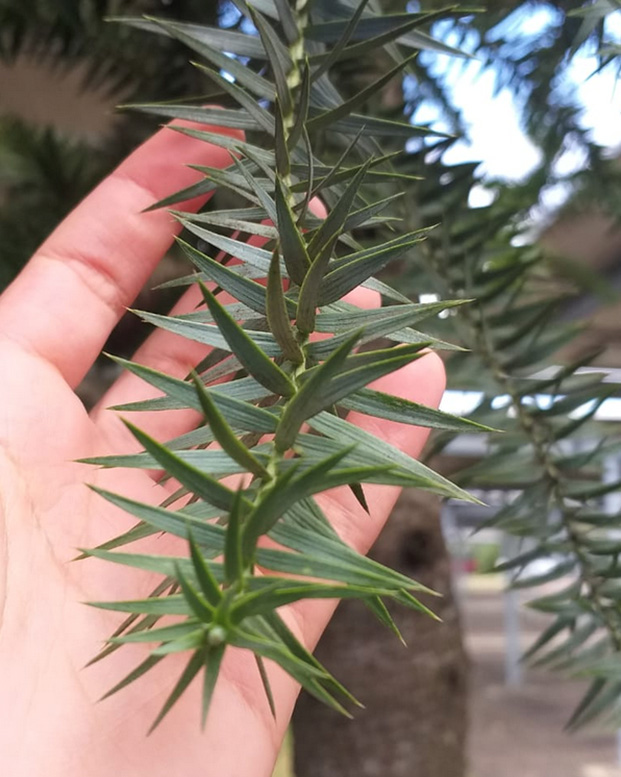News - GLOBE Observer
GLOBE Observer Trees App Used in Documenting a Critically Endangered Species

The Brazilian Atlantic Forest hosts one the world's most diverse yet severely endangered tropical forest biomes. Today, most of the remaining forest is confined to the cool upper elevations of Southern Brazil. The Atlantic Forest is home to many critically endangered species, including the Araucária tree. Known for its unique tufted, sprawling canopy, and prized for its high-quality timber, the Araucária angustifolia, or Paraná pine, remains a culturally important species for the local population – shaping the economy and identity of the human populations that use them. Its large, starchy seeds (pinhãos) have been an essential food since antiquity and are still enjoyed today as a regional delicacy. The seeds are also a vital food resource for wild animals living in the forest. Its lumber, unique and valuable, has also played a large part in nearby communities.

The Araucária is an ancient tree whose ancestors populated the landscape before even the dinosaurs, more than 240 million years ago! Although once dominating the entirety of the Atlantic Forest, the Araucária is now an endangered species that occupies only 2% of its historic range. The high-quality lumber supplied by the Araucária caused an uptick in its harvesting, nearly reaching the brink of extinction in the 20th century. Today, these trees face a new challenge – climate change. Our warming climate has reduced the availability of the cool, moist habitat that Araucária trees need to survive.


The cultural significance and the endangered status of the Araucária tree has stimulated a new citizen scientist project designed to document and support the protection of the Araucária. Biologist Daniela Hostin is using the GLOBE Observer Trees tool to test and develop a new citizen science protocol to document the location, size, sex, and health of Araucária trees in the Brazilian state of Paraná.

A recent study applied machine learning algorithms to Worldview-2 satellite imagery, which successfully demonstrated a new technique for documenting and monitoring this critically endangered species (2021). Satellite data are used to track and protect adult individuals, but immature specimens in the lower canopy have different growth forms and are less easily identified from space, making the tree an important subject for citizen science research. Observations of Araucária trees by citizen scientist enthusiasts will support existing efforts to verify and track the health and persistence of Araucária trees found in municipalities and the Atlantic Forest.

The Araucária tree protocol is now being developed and will be part of a newly funded student-focused K-12 citizen science program: The Interinstitutional Citizen Science Project in Schools (PICCE). Drawing inspiration from both The GLOBE Program and the Open Air Laboratories (OPAL) citizen science projects (2007-2019), PICCE scientists, teachers, and graduate students are building this citizen science program to engage K to 12 students in the scientific exploration of place-based environmental concerns in classrooms across the Paraná State. With a nod to the open science and open data values shared within the citizen science community, PICCE is working carefully to ensure that the Araucária data collected by the new local citizen science app will be interoperable with tree data obtained using the GLOBE Observer Trees Tool.
Is there a tree species that is important to your local environment? Join the current Trees Challenge and submit tree height observations of your favorite trees using the GLOBE Observer app!
About the Author:
Dr. Rusty Low is a scientist on the GLOBE Observer Team. The PICCE Citizen Science Project is led by Dr. Rodrigo Arantes Reis and Dr. Emerson Joucoski, Federal University of Paraná.

Citation:
Saad, F., Biswas, S., Huang, Q., Corte, A.P.D., Coraiola, M., Macey, S., Carlucci, M.B. and Leimgruber, P., 2021. Detectability of the Critically Endangered Araucária angustifolia Tree Using Worldview-2 Images, Google Earth Engine and UAV-LiDAR. Land, 10(12), p.1316. https://doi.org/10.3390/land10121316
Comments
View more GLOBE Observer news here.








